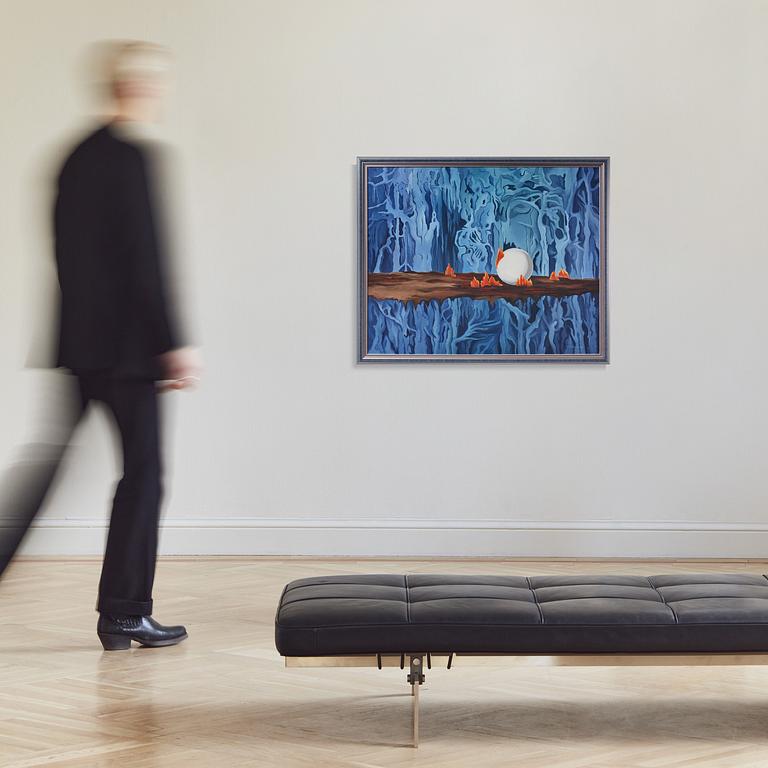Elsa Thoresen
"Brinnande jord III"
Signed E. Thoresen and dated -46. Panel 81 x 100.5 cm.
Mjellby Konstmuseum would like to include this artwork in the upcoming exhibition ”Kust, hav & vatten - Halmstadgruppen med vänner", which will be on view from 7 June 2025 - 2 November 2025 at Mjellby Art Museum, Halmstad.
Provenance
The industrialist Gösta Hägglund (1899-1993), Örnsköldsvik, probably purchased in connection with an exhibition of Elsa Thoresen.
Gifted to Hägglund's housekeeper Brita Sandin, 1993.
Gifted from the above to the current owner.
More information
Compare with the painting ‘Brændende Jord’, 1946, deposited at Statens Museum For Kunst, Copenhagen and ‘Brinnande jord’, 1945, sold by Bukowskis 2024-05-21, 656:665.
The artist Elsa Thoresen was born in the USA but with Norwegian ancestry. She lived in Oslo for a few years, where she also studied. She also studied at the Academie des Beaux-Arts in Brussels, Belgium. Thoresen later moved to Denmark, where she married the artist Vilhelm Bjerke Petersen. They were both central figures in the radical Danish Surrealism, a group that turned against the Nazi German occupiers during the war, but they managed to escape to Sweden, where they became close friends with the artists of the Halmstadgruppen.
Thoresen was greatly appreciated by André Breton, the leading figure of international surrealism. He selected her works for the movement's major exhibitions in 1938 and 1947. After fleeing to Sweden, she worked in both Sweden and Denmark for a few years, but returned to the United States in 1953. Over the years, Elsa Thoresen disappeared into oblivion, but in recent years her work has been rediscovered. In 2018, for the first time in many years, audiences could see a presentation of her work at the exhibition Kvindernes surrealism at Kunstforeningen Gl. Stranden and the Tønder Art Museum in Denmark and the Mjellby Art Museum in Sweden.
In the newly published book on Elsa Thoresen, ‘Good luck, Elsa’, 2024, Thomas Millroth writes the following about the motifs ‘Brinnande jord’ p.185-186; ‘The painting Thoresen showed at Linien II, Brinnande jord, 1946, belongs to the vegetative abstract compositions to which she devoted increasing attention. A dense pale blue background like a fossilised dead background with remnants of clear shapes, and a base of earthy warm matter, and then again the round with its associations of lust, life, desire, consumed in a painful fire. Bjerke-Petersen's contribution was depicted on the same page in the catalogue, an explosion in pure forms of all possible shapes, completely and deliberately freed from any connection to reality. The strange association I have with Thoresen here is with the Scanian Imaginists - Malmö and Copenhagen are not far apart; Den Frie Udstillings Bygning was always a favourite destination for Malmö artists [...] She was well received when she appeared at Louis Hahne's art salon in Stockholm in May 1950. Here the theme of Brinnande jord reappeared, otherwise she is vaguely abstract even in her titles, which are very general and hardly surrealistic or concrete-abstract. The critic Gotthard Johansson delved into literature - for there is certainly a literary strand like a shimmering language in her imagery - and sought parallels to her ‘protoplasm-like world of forms’. And he quoted August Strindberg from Sömngångarnätter:
‘O, urslem, urslem fill up our heart and quench the burning thirst of our spirit.’
I'm guessing that the same message was used in the collection she was to show at ELT Mesen's London Gallery that year.
I want to pause before Burning Earth, 1946, which belonged to Egon Östlund. It is an important work in time. A wasteland in which the earth itself is burning, flames leap up from the scorched umber; they gasp, everything is dead. The underworld is a shade lighter, and like a contrasting mirror image, bright blue shapes rise up, or rather a kind of dissolved organic apparitions. It is not unlike what Gotthard Johansson saw in his review. But the stark contrast between the organic forms also reminds me of the images published at the time of human skin damaged by the atomic bombs over Hiroshima and Nagasaki. But I am probably reading the painting too literally. Thoresen herself eventually tired of the realistic, literary and macabre aspects of surrealism. She also felt a plastic limitation, which is why she opened up more to abstract art.’
Gösta Hägglund (1899 - 1993), together with his brothers, developed Hägglunds & Söner AB into a major international industry. His technical talent and irrepressibly strong will motivated all employees and others to work hard for industrial activities in this building.
Even at a very young age, Gösta Hägglund was curious and fascinated by technology in all its forms, a curiosity he carried with him throughout his life. Gösta Hägglund was born on 29 January 1899 into a large group of siblings. Seven of the original nine siblings went on to devote their entire working lives to what eventually became Hägglund & Söner. Different types of aptitude and talent orientation, together with an unusually well-developed ability for the brothers to like each other and get along, gave weight and breadth to the collaboration. Gösta was the technical driving force in the company during his working life. He was also an honorary doctor at Luleå University of Technology and a long-standing member of the Swedish Academy of Engineering Sciences. Hägglunds developed from a carpentry company (Norrland's largest furniture manufacturer) to Norrland's largest engineering industry with customers all over the world and with products that still form the basis for the manufacture of military equipment, ship cranes and hydraulic motors that today constitute a large part of employment in the locality.
























































